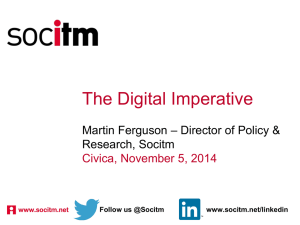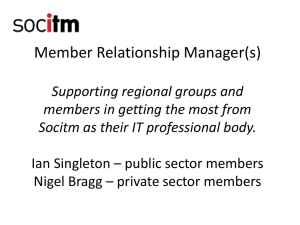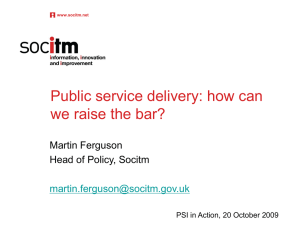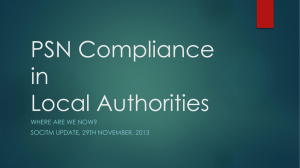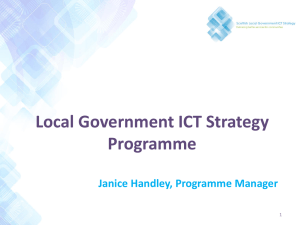Culture and Governance in the Provision of Public Services – a local
advertisement
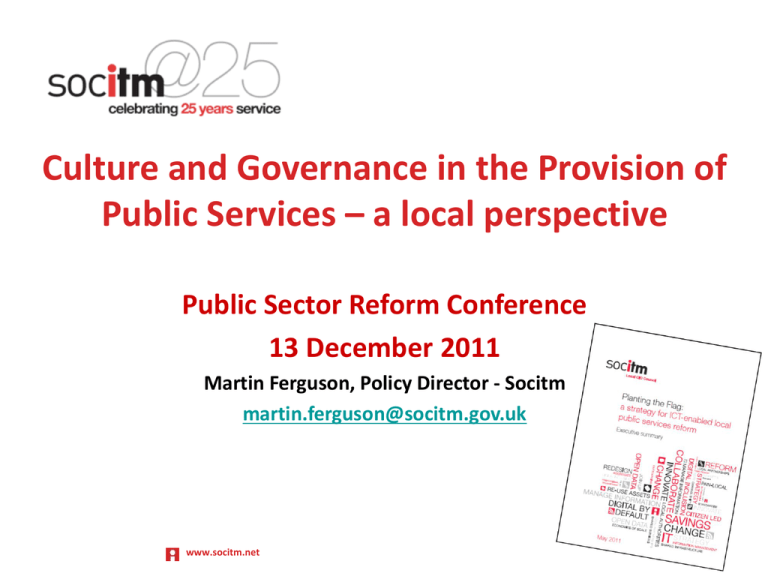
Culture and Governance in the Provision of Public Services – a local perspective Public Sector Reform Conference 13 December 2011 Martin Ferguson, Policy Director - Socitm martin.ferguson@socitm.gov.uk www.socitm.net Culture and Governance in the Provision of Public Services – a local perspective www.socitm.net Culture and Governance in the Provision of Public Services – a local perspective Presentation outline: 1. Future Councils 2. Planting the Flag – cultural change driven by the sector – exploiting culture as an opportunity rather than a barrier 3. Role of the Chief Information Officer (CIO) as an agent of cultural change www.socitm.net Culture and Governance in the Provision of Public Services – a local perspective FUTURE COUNCILS www.socitm.net Future councils - context ‘Big Society’ ‘Open Public Services’ ‘Localism’ Zeitgeist www.socitm.net Understanding? Culture? Skills? Desire? Remuneration? Support? Evidence? Risks? www.socitm.net Future councils – commissioning Transforming Clustered Residual Commercial Lifestyle Future councils – an alternative? www.socitm.net Entrepreneurial Transforming Innovative Flexible Constantly in flux Managed risk www.socitm.net Digitally enabled Future councils – the alternative Culture and Governance in the Provision of Public Services – a local perspective www.socitm.net REFORMING CULTURE AND GOVERNANCE Planting the Flag: a strategy for ICT-enabled local public services reform Business-driven Service outcomes-led Citizen-centred www.socitm.net Planting the Flag: a strategy for ICT-enabled local public services reform CORE PRINCIPLES Innovation Re-design Collaboration www.socitm.net Focus on localities Better understand service users’ needs Build collaboration in services design and delivery across the local public and third sector Share expenditure, resources, assets and savings Examples Sharing front offices e.g. council, primary care trust, police and third sector organisations e.g. Kent, Norwich Reusing and sharing IT infrastructure e.g. Herefordshire County and Primary Care Trust, Public Services Networks in Hants and Kent, CenSus shared IT service in West Sussex Reusing and sharing contracts e.g. Dorset Public Services Network Outcomes-led business change Simplify, standardise and automate Channel shift towards ‘digital by default’ Anytime, anywhere, any device Examples o Business change and benefits realisation e.g. ‘CHAMPS2’ and Vale of Glamorgan o Single, shared information resources (face-to-face, telephone and web channels) e.g. Surrey o Digital delivery and inclusion e.g. Sunderland, ‘Connect Digitally’ – schools admissions and free school meals o Channel strategy/shift e.g. Harrow, Tameside o Flexible and mobile working (‘workstyle’) e.g. Surrey, Hants Shift in ownership and control of data Engage citizens and communities in service design and delivery (co-creation and co-production) Re-use capability and build capacity – resources, information and skills in the community Exploit transparent and open data Examples Personalisation of social and health care e.g. Bromley and Redbridge, Association of Directors of Adult Social Care ‘Easycare’ model ‘Digital City’ e.g. Brighton & Hove’s ‘Council Connect’ Mutual support e.g. Caerphilly’s foster carers on Facebook New ‘smartphone-based’ information services e.g. bus movements, on-demand waste recycling, Lewisham ‘Love Clean Streets’, etc. Planting the Flag: building the capabilities Organisational change ICT CAPABILITIES Collaborative governance Leadership Professionalism www.socitm.net www.socitm.net Leadership role - is a new model required? Management tasks - is a new model required? • Followers do not perceive leadership as a hierarchical relationship • Values such as trust, honesty, respect and a sense of equality most often cited as important • Leadership can be diffuse Focused on defining public value outcomes and then realising them most efficiently Underpinned by effective approaches to value management/benefits realisation e.g. CHAMPS2 www.socitm.net Organisational Change Outcomes Realise Benefits Redesign Implement Organisational Change Public, private and third sector stakeholders brought together in collective forums with public agencies Consensus-oriented decision making Replaces adversarial and managerial modes of policy making and implementation Critical variables: o prior history of conflict or cooperation o incentives for stakeholders to participate o power and resources imbalances o leadership o institutional design Collaborative www.socitm.net governance Critical success factors: face-to-face dialogue trust building developing commitment shared understanding ….. focusing on “small wins” gives rise to a virtuous cycle of collaboration Source: C Ansell and A Gash (2007) “Collaborative Governance in Theory and Practice” Oxford Journals www.socitm.net Collaborative governance Forth Valley GIS – joint venture company Herefordshire County Council and Primary Care Trust – shared chief exec and management team ‘Tri-Boros’ - London Boroughs of Hammersmith & Fulham, Kensington & Chelsea, and Westminster – service by service merging children’s services under one director and management team Cambridgeshire and Northamptonshire County Councils – joint venture company for resource planning Worthing and Adur District Councils – joint chief executive and strategic committee, simultaneous executive meetings London Boroughs of Newham and Havering – single CIO, centres of excellence Collaborative www.socitm.net governance Socitm – the association for ICT and related professionals in the public and third sectors, and suppliers to these sectors. Socitm’s activities include: Member support, professional development and accreditation Policy and influence Insight research and professional guidance e.g. IT Trends, Local e-Government Now series Benchmarking – Better Connected, IT, Channel Value Specialist consulting www.socitm.net International – partner associations Professionalism Culture and Governance in the Provision of Public Services – a local perspective ROLE OF THE CIO www.socitm.net Culture and Governance in the Provision of Public Services – role of the CIO www.socitm.net Culture and Governance in the Provision of Public Services – role of the CIO … or Captain Scarlet --action hero with mysterious super-human powers of indestructibility? www.socitm.net The Chief Information Officer (CIO) role as an agent of cultural change www.socitm.net Role of the CIO – ten steps to IT leadership success 1. Tell the narrative of change (not how IT will change) 2. Handle the inherent complications of change (don’t further confuse it) 3. Take risks (don’t avoid them) 4. Provide solutions to known (and unknown) problems because that defines innovation 5. Position IT as a key enabler and transformer of organisations and places (not a blocker or salvation) www.socitm.net Role of the CIO – ten steps to IT leadership success (cont’d) 6. Understand the potential of the networked world 7. Route everything back to service delivery on the ground – nothing else really matters 8. Grab all opportunities as they are presented 9. Put the ‘customer’ at the heart of all design and build solutions 10. Put the fun, dynamic energy and inspiration into ITenabled transformation. Source: Martin Reeves, CEO – Coventry City Council www.socitm.net Culture and Governance in the Provision of Public Services – a SOLACE perspective What might your local authority look like in the future? How can organisations stimulate innovation? Are we clear what outcomes we are able to deliver? Are local authorities making best use of the internet? What is the role of social media? How may decision-making structures need to adapt? What is the innovation challenge for leaders? www.socitm.net THE FUTURE? Culture and governance in the Provision of Public Services – reflections from a local perspective Ethos, psychology and reward Governance and management arrangements and accountability in service provision Culture – professional judgement, personal responsibility Long term strategic thinking The role of Innovation in public service delivery Sustainable delivery of services and promotion of green approaches Encouraging flexibility and developing capacity Management of renewable and non-renewable resources www.socitm.net Culture and governance in the Provision of Public Services – a local perspective - sources www.socitm.net www.nlgn.org.uk/public/2011/future-councils-life-afterthe-spending-cuts/ www.solace.org.uk www.champs2.info http://jpart.oxfordjournals.org/content/18/4/543.abstract martin.ferguson@socitm.gov.uk www.socitm.net
